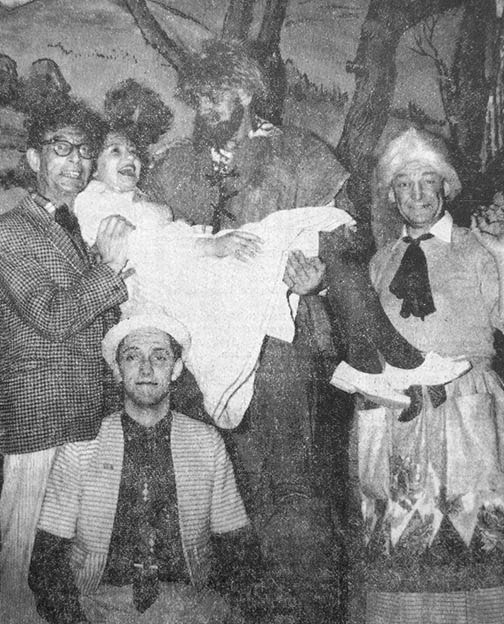"The most important thing in acting is honesty. If you can fake that you've got it made." Author unknown
Jim Cameron
The Cranbrook Community Theatre Society, now in its 51st year, has set yet another milestone in its history, that is to say, it has survived for 51 years.
Further, it has remained in the same building for 41 of those years: the city-owned former Masonic Temple built in 1910 and renamed The Studio when the theatre group became the tenants in 1974.
Both feats are worthy of praise in the annals of amateur theatre. In truth, the history of the CCT may well be traced by a somewhat perforated line as far back as the 1920s, and includes thousands of Cranbrook individuals, a line that, in some cases, spans four or more family generations.
In December, 1920, a company of local amateurs presented the comedy "The New Boy" at the old Cranbrook Auditorium (site of the present day Armond Theatre) on Norbury Avenue for one night. It was an apt title as it was, barring a handful of previous presentations of Gilbert and Sullivan operettas, one of the very first locally produced non-musical plays. The reviews were good and the house was packed. The cast even took it on the road for a performance at Wycliffe early the next year (Wycliffe featured its own amateur theatre group at the time).
Things simmered acting-wise until "The Cranbrook Follies of 1923," featuring the short play "Happy Country Girl."
With the concurrent introduction of the Rotary Club's Minstrel Show (entirely politically incorrect by today's standards but an annual hit for many years) local theatrics gained a foothold made even stronger by the formation of the Cranbrook Musical Society the same year.
The Society tackled both Gilbert & Sullivan's "HMS Pinafore" and "Trial by Jury" within a few months, running shows at the Auditorium for three nights plus a Saturday matinee and it wasn't just the actors who garnered attention.
A Courier newspaper review of "Pinafore" stated: "The excellence of its [the orchestra's] work created a taste for good music that months of jangling jazz will fail to dispel." Ouch, for jazz. Lauds and applauds for musical theatre.
Local amateur histrionics were on the upswing and given another big push by the Gyro Club, who undertook a number of large musical comedies over the next few years, even going so far as to bring in professional directors from as far away as Chicago, who carried with them enough of a hint of the "big-time" to guarantee attendance.
 Pictured: The late Gracie McNeil, who made her early stage appearances in the 1920s as “Little Gracie Higgins. Gracie was voted Cranbrook’s Citizen of the year in 1977. - Courier June 2, 1965.
Pictured: The late Gracie McNeil, who made her early stage appearances in the 1920s as “Little Gracie Higgins. Gracie was voted Cranbrook’s Citizen of the year in 1977. - Courier June 2, 1965.
Churches also got into the act, so to speak; the Young People's Society of the United Church, the St. Mary's Dramatic Society and the Anglican Church Players also tread the boards. By the 1930s, even the Boy Scouts were taking turn with regular productions at the Anglican Parish Hall (now Kennedy Hall), a venue that has served countless theatrical presentations over the years.
In 1936, a dedicated group formed the Cranbrook Little Theatre Association (a common title for amateur groups at the time and still used today) and began giving regular one-act plays at the Parish Hall. Admission was by membership only, with the group performing up to a dozen plays a season with occasional public forays at the Auditorium.
A public workshop in Windermere in June, 1937, saw the formation of the East Kootenay Drama Association which included Golden, Invermere, Windermere, Fernie, Kimberley, Creston and Cranbrook. The main purpose of the group was the annual drama festival, of which Cranbrook hosted the first in March, 1938, an undertaking which has continued throughout the East Kootenay almost unabated since that time.
From 1939–1945, the Red Cross Thimble Theatre entertained wartime audiences, joined by yearly productions staged by the students of the St. Eugene's Nursing School and the Cranbrook High School, the latter of which has carried on the tradition to the present day.
Throughout the late 1940s, and into the early 1960s, the local drama chapter of the East Kootenay Arts and Craft Association performed regularly.
It was in February, 1964, that a group of individuals officially formed the Cranbrook Community Theatre and presented its first production "Jack and the Beanstalk." Directed by Fred Cawte, it featured Bud Abbott, who had won drama festival top honours the previous year in "A Breath of Spring" with the Cranbrook Players. The play was very well-received, inspiring the local Courier to state, "If this ... first production is any indication of the support the Cranbrook Community Theatre will receive, live presentations of family comedies will become a regular feature," And so they have.
And, as a final note, from her role in "Happy Country Girl" in 1923, Gracie McNeil (nee Higgins, granddaughter of A.B. Grace, owner and publisher of The Prospector, among the first newspapers in the district) acted, sang, danced, directed and served on the boards of local theatre groups for over 50 years. She, along with Flo Dorris, became the first lifetime members of the Cranbrook Community Theatre many years ago.
And so, a very long standing ovation to the countless dedicated actors, directors, technicians, musicians, backstage and front of house workers who brought live theatre to Cranbrook for over 100 years and to those who continue to do so today. May your curtain never fall.
Jim Cameron is the author of Janus: Cranbrook Then and Now, Vol. 1, available at various locations in the Cranbrook area, including the Daily Townsman.
